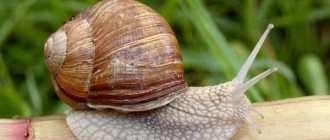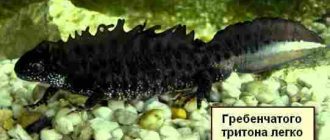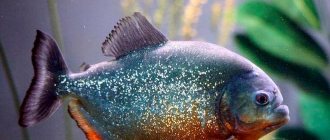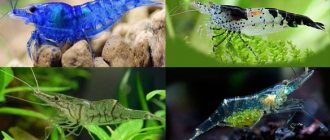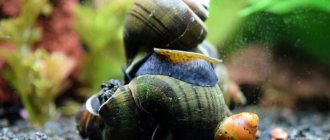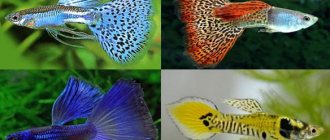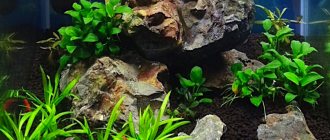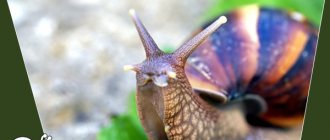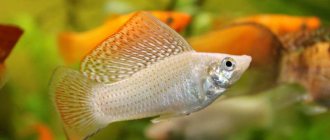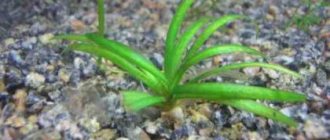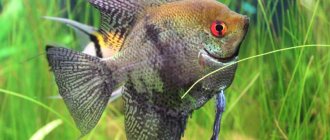Aquarium frogs are amphibians adapted to life in an artificially created aquatic environment. Some species that are now bred in captivity are also found in nature, but others were obtained as a result of selective breeding.
These pets often require special conditions and cannot always live in the same aquarium with fish and shellfish. In addition, they need an island of land where they can take a break from the aquatic environment.
Specially bred
Frogs have long been a part of pet collections. You won’t surprise anyone anymore with these cute amphibians swimming in the aquarium next to the fish. Many pet supply stores display containers with frogs.
It's worth noting right away for those who might think that it is too cruel to keep a frog in a confined space. Aquarium frogs are animals that were bred specifically to be kept in a tank. The entire diversity of species is the result of selection work on individuals living in the natural environment. Their ancestors were African frogs living in bodies of fresh, stagnant water.
For aquarists, this is a completely new experience that requires a special approach. Some types of frogs do not tolerate being in the same aquarium with fish for a long time. There should be islands in the water on which amphibians can climb and rest. That is, the ideal option is an aquatic terrarium, which is the name given to an aquarium that is partly occupied by soil (filler) and partly by water.
Dart frogs (Dendrobatidae).
Darter frogs - Dendrobatidae
A South American group of amphibians, famous for their bright and unusual colors. Conventionally, all dendrobatids can be divided into crepuscular (with protective coloration) and diurnal - poisonous (with warning coloration). The poison of poison dart frogs is one of the most dangerous; the Indians of Latin America smeared arrowheads with it.
Dart frogs raised in captivity produce practically no toxins, due to a lack of certain substances that amphibians obtain in the wild from termites, ants, ticks, etc. The poison of frogs of the genus Phyllobates is deadly for mammals (if it gets into the blood). If it comes into contact with the skin, the toxin causes pain, swelling and irritation. Scary? Then take a closer look at the genus Colostethus, these frogs are not poisonous.
If it comes into contact with the skin, the toxin causes pain, swelling and irritation. Scary? Then take a closer look at the genus Colostethus, these frogs are not poisonous.
The poison dart frog is several centimeters in size, the cost, depending on the species, is 1,500-10,000 rubles/individual. It is better to keep poison dart frogs in pairs; same-sex individuals have serious conflicts.
Experienced choice
Those involved in breeding aquarium frogs usually buy spur frogs (Xenopus) and dwarf frogs (Hymenochirus). These are the most common species that live comfortably in a home pond. They are quite happy with being kept in an artificial environment. Several selectively bred species of white frogs are widespread and are not picky about the volume of glass habitat. But you will still have to provide the necessary minimum for keeping aquarium frogs. The smallest tank volume where frogs will not feel inconvenienced is 20 liters.
Reproduction
Before white frogs breed, the male develops characteristics such as black stripes along the legs and on the sides of the toes. They begin to make a quiet "tick-tick" sound, like a ticking clock. The result is a melodic mating call of white frogs. During mating, the male grabs the female from behind, and within an hour the frogs begin breeding, that is, laying eggs.
The female places all eggs one at a time on the stem of the plant. Very quickly the shell of the egg becomes hard, and after a couple of days the tadpoles hatch. For their good growth at home, you can feed them with chopped lettuce or spinach leaves.
For dwarf frogs, reproduction occurs a little differently. Initially, the male makes several short grabs. If the female is not inclined to reproduce, then the male nobly retreats. And if a female dwarf frog becomes numb and trembles throughout her body, this means a signal of readiness for fertilization. When the male receives such a signal, he closes his front paws tightly. Dwarf frogs can stay in this position for about a day.
Appearance
Xenopus and Hymenochirus differ significantly from each other. Just read the description of aquarium frogs. When choosing a specimen in a pet store, it is better to take a good look. Employees of such stores do not always pay due attention to this aspect of keeping frogs and often house them together. A spurred individual can be identified by its color. They are usually either white or light pink with red eyes. Some sources report that white aquarium frogs were bred by Russian scientists for laboratory research. But this statement is controversial.
If, when purchasing, you come across a grayish or brown frog with spots, these are real African amphibians. In order not to confuse them with spurs, you should definitely pay attention to the appearance of the fingers and muzzle. All limbs must have clearly defined membranes. In wild species, the body is dense, larger than artificial ones, with a uniform color. Hymenochirus have long thin legs and a pointed muzzle, with a characteristic “smile”. The eyes are set close. The dwarf frog bears its name quite rightly. In an adult, the body length reaches only four centimeters. Spurs are twice as large, even at a young age. Hymenochirus females are typically larger and thicker than males. During the period of active breeding, the sides of females swell and they look even rounder. At a young age, only a specialist can distinguish the gender of these aquarium frogs.
Narrowmouths, or microfrogs (Microhylidae).
Tomato narrowmouth - Dyscophus antongilii
The most famous, and perhaps the most striking representative of the family in every sense is the tomato narrowmouth. Size 6-10 cm. The frog is a burrower, so moist soil 5-8 cm thick is required. The maintenance temperature is standard for tropical inhabitants: 23-26°C, higher temperatures (about 30°C) can cause the death of the narrowmouth. Burrowing frogs are not suitable for my terrarium, so I will not dwell on them in detail. Although, of course, they look amazing...
Behavior
There is also a noticeable difference in the behavior of the two species. If Shportsevs can be safely given a medal for activity and arrogance, then Hymenochiruses, on the contrary, are distinguished by calmness and balance. Spurs do not have a saturation threshold, that is, they can constantly pester, or even eat, the fish. Dwarfs, on the contrary, lead a secretive life and try to “shine” less.
Maintenance and care
It is better to start with clawed aquarium frogs, the maintenance of which is slightly different from the care of dwarf frogs.
These small creatures live completely submerged in water. The aquarium for them should be filled to the top with water, but 1/3 of the part is still left without water, for air flow. The aquarium for them should be at least 20 liters for one individual. In the same ratio, it is better not to put more than three frogs in a seventy-liter container. They prefer to be at the bottom of the reservoir, where they stay most of the time. Therefore, it is better to purchase a long and low container than a short but high one. In general, both types are undemanding to care.
Keeping an aquarium frog Hymenochirus should begin with studying their life in the wild. In their natural habitat, they often live in shallow swamps and puddles with not very clean, but well-heated water. Therefore, it is necessary to maintain a constant temperature in the aquarium from +20 to +24 °C. At lower temperatures, the risk of illness increases. But you shouldn’t worry too much about the purity of the water. On the contrary, frequent fluid changes are unacceptable. Frogs are also harmed by strong currents, which in aquarium conditions can create a powerful filter. But at the same time, oxygen saturation is mandatory for a glass pond with dwarf frogs. To provide them with aeration and protect them from the current, you need a long aquarium to be able to create a “stagnant” place.
The quiet nature allows the dwarf aquarium frog to live in the same aquarium with any fish, provided that they are slightly larger than the frog. A community aquarium should be equipped with various types of shelters.
But let's return to the Shportsevs. The maintenance and care of the described aquarium frogs is not entirely different from the maintenance of the Hymenochirus frog. They do not require land; they can simply live in water. This species is famous for its nervousness, “arrogance,” tactless behavior, and what an appetite! They swallow everything that fits in their mouth. Therefore, it is better not to cover the bottom of the aquarium with soil or small stones, since these gluttons can swallow pebbles, and they will get stuck in their intestines (sand comes out naturally). The same goes for vegetation. Either hard-leaved algae are chosen, or artificial substitutes for aquatic flora are installed.
Clawed aquatic frogs are not able to live on land. The aquarium should be selected with a capacity of 15-20 liters per frog. You also need to worry about having a lid over the aquarium, because frogs can easily jump out. The temperature should be between +21 and +25 °C.
Compatibility
Not all species can be kept with other animals. Consider the temperament, activity, conditions for frogs and other animals.
Most frogs prefer stagnant water without strong filtration or currents. Some fish species will not survive in such an environment.
Spurs should not be housed with small and inactive fish.
Hymenochirus gets along with inactive, calm fish, but too active fish species will put it into a stressful state. Do not add labyrinthine fish to Hymenochirus. Amphibians coexist well with shrimp and non-predatory turtles.
Litter
You don't have to use soil in the tank. This is the most affordable and easiest way to keep your aquarium clean for as long as possible. If the frog house is without soil, then it is advisable to place it on a dark, brown base - a dark table, for example. This color will correspond to the conditions of the natural environment. But if, nevertheless, soil is necessary for decorative reasons, then it is better to cover the bottom of the reservoir with large pebbles, which the frog will not be able to turn over, much less lift with its paws.
Substrate
Even in the case of this tree frog, providing a good substrate in the enclosure will help create and maintain an environment similar to its natural warm, humid tropical habitat.
Construct the foundation of the bottom of the tank from large washed gravel, covered with soil that does not contain chemicals. Larger pieces of bark can then be used for a larger base.
Cover any exposed soil with sphagnum moss, which helps retain moisture, which provides the humidity these amphibians need.
Avoid fine gravel or bark shavings that frogs might accidentally ingest. Some owners prefer a simpler approach for temporary tanks, simply lining the tank with paper or paper towels for easier cleaning.
However, with such minimal flooring, maintaining adequate humidity is much more difficult.
Vegetation
The big question remains whether it is advisable to keep live plants in an aquarium with clawed fish in general. Frogs use their claws (their claws give them their name) to cut greens into crumbs. If a person does not like artificial plants in aquariums, then Anubias can serve as a compromise option. All types of these plantings are endowed with strong leaves. By the way, in Africa, some species of these plants grow in reservoirs where clawed frogs live. Therefore, by planting them in an aquarium, their natural background is thus recreated. If the choice of vegetation is not important, then it is better to purchase silk ones from artificial decorations, which do not harm the membranes of frogs.
Hymenochiruses behave less destructively towards plants. Therefore, they can select natural algae, but which are suitable for muddy water.
Description
Clawed frogs are the most ancient amphibians. Their fossil remains have been discovered, dating back 1.85 million years.
A smooth frog from the order of tailless amphibians of the spiny family. It is classified in this family due to the presence of spur-claws up to 3 mm long on three toes of the hind legs. They are needed to float on water, cling to plants, protect themselves from enemies and hunt. Because of them and their natural habitat, the smooth clawed one received another name - the African clawed one.
Taming
Some sources attribute the ability to tame clawed frogs. Supposedly they can recognize one owner. But there is no evidence to support this. More often, pet store websites are guilty of such information, thus trying to sell a product, capitalizing on the desire of some potential buyers to stroke their pride. There are not many examples where frogs were trained to receive food only from the hands of the owner. But here the trick is only a reflex: “smell-hands-food.” There can be no talk of any emotional attachment to a person, due to the limited intelligence of aquarium frogs, photos of which are presented in this article.
Copepods (Rhacophoridae).
House Copepod - Polypedates leucomystax
Famous for its ability to fly. More precisely - planning. The membranes between their fingers help them with this. Captive breeding of Polypedates leucomystax, the house copepod, has been mastered. The female reaches a length of about 10 cm, males are twice as small. This is due to the fact that during the breeding season the female carries the male on herself for a long time. It feeds on insects; the temperature and humidity are standard for tropical frogs (21-26°C, 80% and above). The cost is 2000 - 8000 rubles, there are few offers, so you will have to look.
Feeding
Any live food that is sold for fish is suitable for feeding dwarf frogs. The best and most affordable food is bloodworms and tubifex. Frogs are predators by nature and can be attracted to a moving target. They eat the dead carcasses of the same bloodworms that drift motionlessly in the aquarium extremely reluctantly. But it happens that some individuals are quite content with frozen or dry food. And yet, this little frog at all stages of growing up is a predator (which cannot be said about spur frogs), and this will have to be taken into account.
Spurs are more unpretentious in feeding, even too much, which is both a plus and a minus. They are prone to overeating, so the owner needs to monitor this. Their body should be flattened. If their figure begins to acquire spherical features, this is an alarm bell, it’s time to put them on a diet. If obesity is allowed to occur, a number of related diseases will arise. Xenopus are fed bloodworms, chopped pieces of lean beef, fish, mealworms and earthworms. As you can see, from the above, the owner of the spur frogs will not need to worry much about what to feed the aquarium frogs. Adults are fed no more than twice a week. Many owners are touched and amused to watch how they react violently to the appearance of food in the water by smell, pounce, and then stuff the pieces into their mouths with their short front paws.
Breeding
Reproduction is stimulated by increasing water temperature and updating it to clean water. Before breeding, black stripes appear on the male's paws, then he makes melodious sounds, calling the female to mating games. For spawning, a spawning tank depth of at least 20 cm is required. The female lays 50-200 eggs; after the eggs appear, the parents should be separated from the brood.
Newborn tadpoles are small in size, no more than 3 mm. Starter food: rotifers and ciliates. After a year they become adults.
Frog diseases
With good care, frogs live up to 15 years, but, like any animal, they can get sick. A very common disease among waterfowl is the so-called red foot, or sepsis, which occurs due to toxins entering the blood: due to an overly polluted aquarium, pesticides or stress. If the disease is not noticed at an early stage, the animal is guaranteed to die.
Also, poor care of frogs often leads to the release of the cloaca. Reasons: monotonous diet. They are treated with a course of vitamins, cleaning and repositioning of the cloaca. The outer part of the prolapsed organ is treated with a solution of potassium permanganate and returned to its place.
Owner reviews
According to owner reviews, aquarium frogs are good pets. It is interesting to watch their actions; they soon remember their owner and become attached to him. Breeders are attracted by the ease of maintenance and lack of hassle. Well suited for beginners and people with allergies to wool or leather. The animal can also be entrusted to a responsible child due to the ease of care.
